Daughter & I set up her 3D printer in my shop. A lot of fooling around getting it dialed in. It's running overnight. See if we succeeded tomorrow. She has ordered a kit to double the make size. Neither of us know what we are doing. Got a roll of carbon fiber cloth and some carbide end mills.
-
Welcome back Guest! Did you know you can mentor other members here at H-M? If not, please check out our Relaunch of Hobby Machinist Mentoring Program!
You are using an out of date browser. It may not display this or other websites correctly.
You should upgrade or use an alternative browser.
You should upgrade or use an alternative browser.
POTD- PROJECT OF THE DAY: What Did You Make In Your Shop Today?
- Thread starter wachuko
- Start date
- Joined
- Nov 25, 2015
- Messages
- 8,235
I made an mandrel to mimic my lead screw .. I plan on replacing the bearing that they provided for the power feed with a sleeve that is the bearing, and gear holder. I'll turn it between centers, then grind the bearing race. I will shrink the sleeve onto the mandrel then heat and press it out once finished. I'll part off part of it, and put the key slot in the parted off piece and woodruff key 180degrees off to transfer to the gear. This is making an adaptor for a Clausing 8520 to use a bridgeport power feed.
Last edited:
- Joined
- Nov 23, 2014
- Messages
- 2,606
POTD turned out to be TWO POTD. That’s what happens when I have to fix something before getting my actual project started. Ah, it’s shop time so what the heck!
The intended POTD involved using my Tennsmith stomp shear on some 16-gauge galvanized. The shear blade has a rake on it, the shearing starts on the RH side and works its way to the LH side. Since the pulling action is from right to left, I usually put my material up against the LH side graduated edge so the material is pulled into the stop.
My blank was about 24” wide and started to cut, but only made it about halfway along the edge. It’s a pretty simple mechanism; step down on a pedal that pivots off an axle. There’s a linkage on either side of the pedal that attaches to the shear bar. You get about an 8 to 1 mechanical advantage so at my 175 lbs., I get about 1400 lbs. of down force on the shear bar.
Houston, we have a problem when the stomp shear only scores a piece of matte board?!?
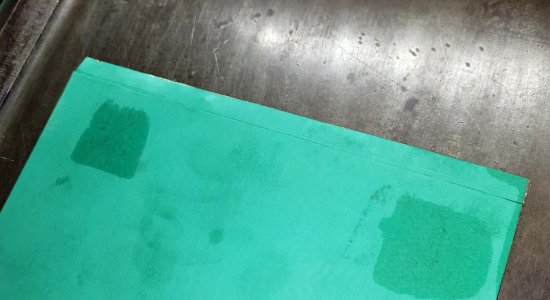
What the heck?!? I stepped on the pedal with nothing in place and saw the shear blade making it past the bottom shear bar. I set in a piece of matte board and it wouldn’t shear. Then I noticed as I stepped down that the pivot on the LH side was lifting up. Moved some crap out of the way and discovered the 1 ¼” diameter pivot pin between the shear’s frame and the back of the pedal was missing!
Ah, here's your problem. . . The axle pin for the foot pedal is missing!
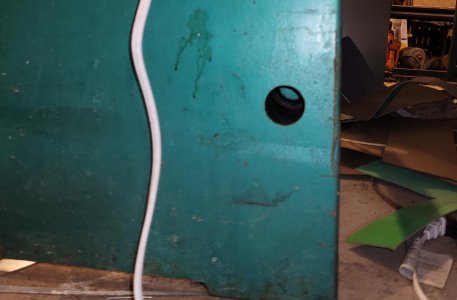
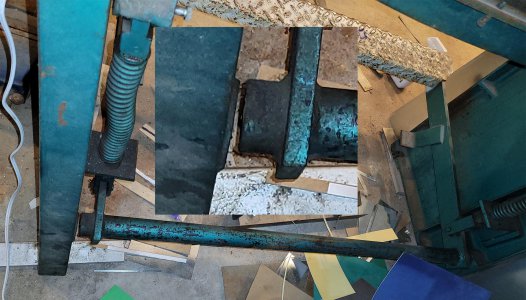
RH side for comparison
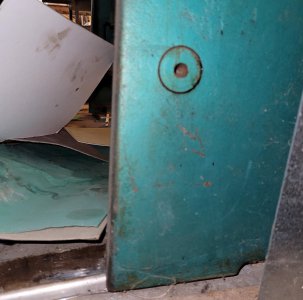
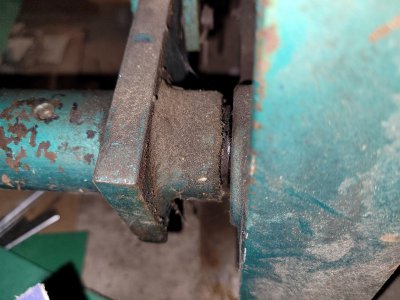
The hole measured 1 ¼” diameter; figured on sticking in a piece of CRS. I shoved a tape measure into the hole to get a rough length and heard the pivot shaft sliding in the back tube. I stuck a magnet through the frame and tube and was able to get the pivot pin back up to the frame. Turns out the pin is threaded 3/8”-16. Ran in a bolt and was able to manipulate the pedal tube and slide the pivot pin back in place.
The RH side pedal frame is threaded; looks to be a headless set screw run through the tube and pivot pin. Don’t know if a previous owner changed things on the LH side, but the pivot pin was held in place with a ¼” roll spring pin. I was able to rotate the pin back into alignment, drive out the old pin and pound in a new one.
I was able to run a 3/8" bolt into the end of the axle and pull it back into position
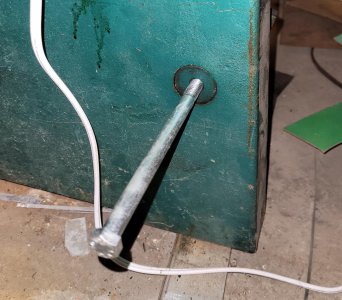
Looks like a piece of spring roll pin
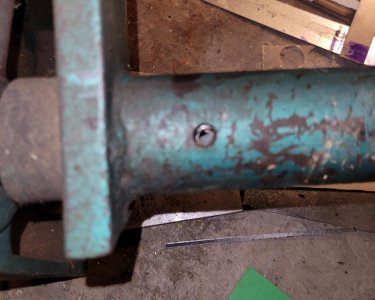
Temporary fix is a new spring pin. I'm of the school of thought that if it failed once and there's no assignable cause, it will fail again. I will be replacing the roll pin with a cap screw. This pin carries a lot of torsional load; makes more sense to have a solid pin that a spring pin.
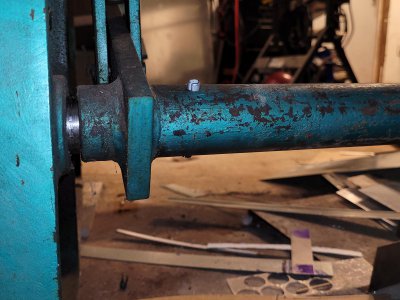
Curiously, the Tennsmith manual shows the pivot pin and retaining pin, but doesn't not list them in the manual. I'm thinking the pin part# 61 should be solid instead of a spring pin.
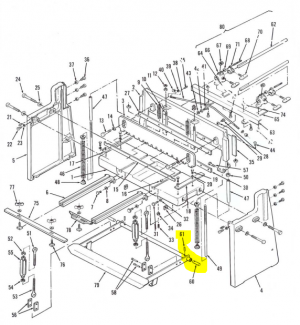
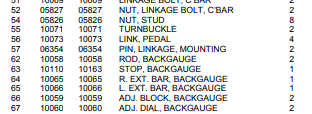
For belt and suspenders, I made a plastic bushing that screws into the pivot pin. Started with 2” polyethylene. Faced, center drilled, drilled a 3/8” central hole, cut a shoulder on the face which would bear against the pivot pin and parted. Ran it down with a 3/8” button head cap screw with a drop of Loctite.
Faced, center drilled and drilled a through hole for a retaining bolt
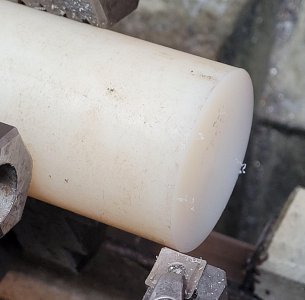
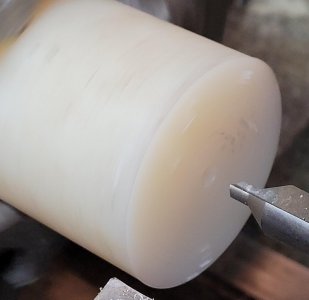
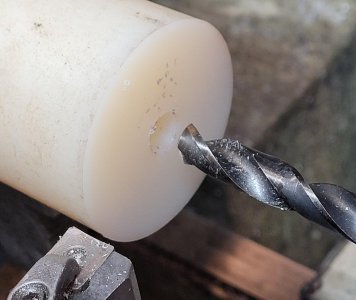
Turned a shoulder to around 1.10". The pivot pin sets subflush to the frame by about 0.090". The face of the shoulder will bear against the end of the pin while the larger diameter will keep it from walking into the frame. Way overkill on my part as the root cause of the problem was likely the previous owner swapping in a spring pin for a solid pin.
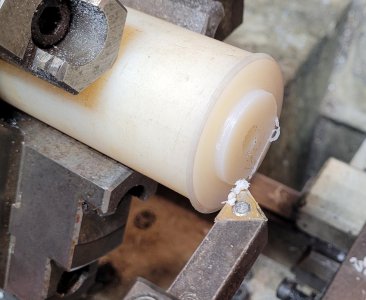
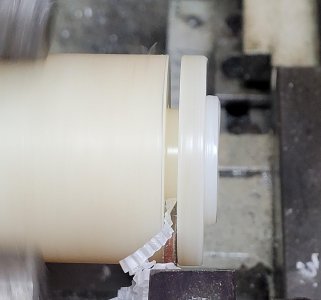
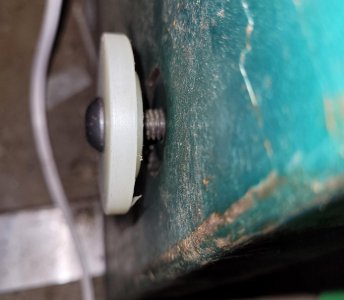
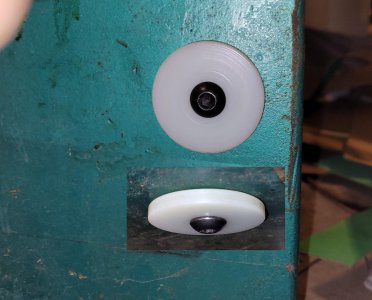
The shear works great though I will be replacing the spring pin with a cap screw. Now onto the real POTD.
Thanks for looking, Bruce
The intended POTD involved using my Tennsmith stomp shear on some 16-gauge galvanized. The shear blade has a rake on it, the shearing starts on the RH side and works its way to the LH side. Since the pulling action is from right to left, I usually put my material up against the LH side graduated edge so the material is pulled into the stop.
My blank was about 24” wide and started to cut, but only made it about halfway along the edge. It’s a pretty simple mechanism; step down on a pedal that pivots off an axle. There’s a linkage on either side of the pedal that attaches to the shear bar. You get about an 8 to 1 mechanical advantage so at my 175 lbs., I get about 1400 lbs. of down force on the shear bar.
Houston, we have a problem when the stomp shear only scores a piece of matte board?!?

What the heck?!? I stepped on the pedal with nothing in place and saw the shear blade making it past the bottom shear bar. I set in a piece of matte board and it wouldn’t shear. Then I noticed as I stepped down that the pivot on the LH side was lifting up. Moved some crap out of the way and discovered the 1 ¼” diameter pivot pin between the shear’s frame and the back of the pedal was missing!
Ah, here's your problem. . . The axle pin for the foot pedal is missing!


RH side for comparison


The hole measured 1 ¼” diameter; figured on sticking in a piece of CRS. I shoved a tape measure into the hole to get a rough length and heard the pivot shaft sliding in the back tube. I stuck a magnet through the frame and tube and was able to get the pivot pin back up to the frame. Turns out the pin is threaded 3/8”-16. Ran in a bolt and was able to manipulate the pedal tube and slide the pivot pin back in place.
The RH side pedal frame is threaded; looks to be a headless set screw run through the tube and pivot pin. Don’t know if a previous owner changed things on the LH side, but the pivot pin was held in place with a ¼” roll spring pin. I was able to rotate the pin back into alignment, drive out the old pin and pound in a new one.
I was able to run a 3/8" bolt into the end of the axle and pull it back into position

Looks like a piece of spring roll pin

Temporary fix is a new spring pin. I'm of the school of thought that if it failed once and there's no assignable cause, it will fail again. I will be replacing the roll pin with a cap screw. This pin carries a lot of torsional load; makes more sense to have a solid pin that a spring pin.

Curiously, the Tennsmith manual shows the pivot pin and retaining pin, but doesn't not list them in the manual. I'm thinking the pin part# 61 should be solid instead of a spring pin.


For belt and suspenders, I made a plastic bushing that screws into the pivot pin. Started with 2” polyethylene. Faced, center drilled, drilled a 3/8” central hole, cut a shoulder on the face which would bear against the pivot pin and parted. Ran it down with a 3/8” button head cap screw with a drop of Loctite.
Faced, center drilled and drilled a through hole for a retaining bolt



Turned a shoulder to around 1.10". The pivot pin sets subflush to the frame by about 0.090". The face of the shoulder will bear against the end of the pin while the larger diameter will keep it from walking into the frame. Way overkill on my part as the root cause of the problem was likely the previous owner swapping in a spring pin for a solid pin.




The shear works great though I will be replacing the spring pin with a cap screw. Now onto the real POTD.
Thanks for looking, Bruce
Last edited:
- Joined
- Nov 23, 2014
- Messages
- 2,606
POTD was making a bracket to mount a garden-watering manifold. My refuse in my shop. My wife’s refuse is her garden. Her garden beds are in boxes made from 6” wide cinder blocks 3 courses high. She spent a lot of time setting the block on ¾” foundation-grade plywood. Bottom 8” is rock, 2nd 8” is sand, and the top 8” is top soil/compost. The top deck is 8” wide cedar boards. It’s really nice to plant/weed/harvest without crawling on your knees.
I plumbed a hydrant to her garden for watering which she runs into a 4-zone programmable manifold. One water line runs in, up to 4 lines run out to different parts of her garden. Each zone has sprinkler lines running through the beds. She can program in the number of hours each zone gets water. On top of it all, the manifold has provisions for a moisture sensor so it only kicks on if the ground is dry.
She used to mount the manifold directly on a “Y” off the hydrant. Problem is our well water has a fine silt in it even after 29 years in our house. The house has a large whole-house filter to keep from plugging up the water softener, but the “T” to the garden/shop is unfiltered. Her small trickle hose end fittings were getting clogged and needed to be flushed every year. Our solution was to add a whole-house filter like in the house, but that meant the manifold would need to be remote mounted. Hence, the project of the day.
Now that I have a working sheet metal shear (see the above POTD. . .), my material of choice was 16-gauge galvanized. I cut a piece of chipboard for a prototype. Dykem’d up the 16-gauge and started punching/cutting. The bracket is “U” shaped with a tab on the bottom that captures the bottom edge of the manifold. The top is secured with a piece of 1/8” aluminum which screws to the bracket.
I needed a 1 1/4" hole but my punches for the Roper Whitney 218 press go from 7/8" up to 1 1/2". So, nibbled away at the 1 1/4" hole with the 7/8" punch
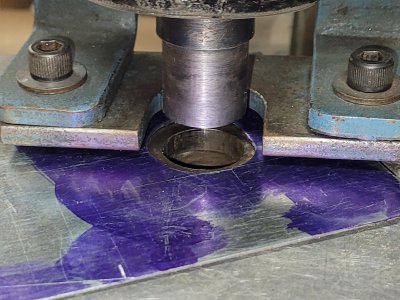
Used a 1/2" x 3/4" rectangular punch to knock in the open-ended slot that will capture the inlet hose fitting
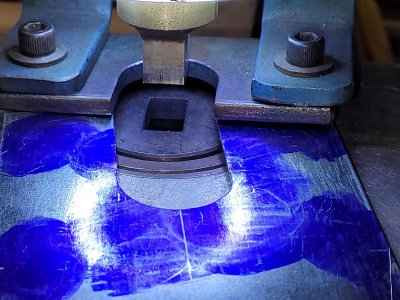
Trimmed the sides of the blank with a 6" corner notcher
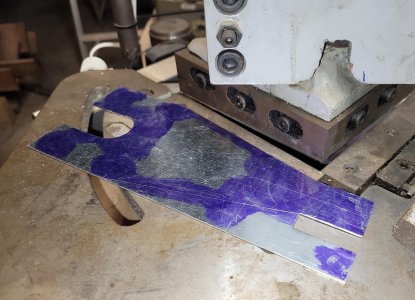
Radiused the corners (sander would work too)
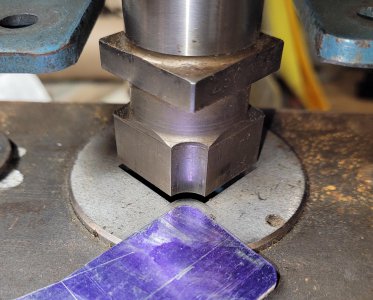
Set the 1/8" aluminum retaining plate in place, scribed the remainder of the 1 1/4" hole for capturing the inlet hose, and traced the outline of the mounting screw holes onto the aluminum.
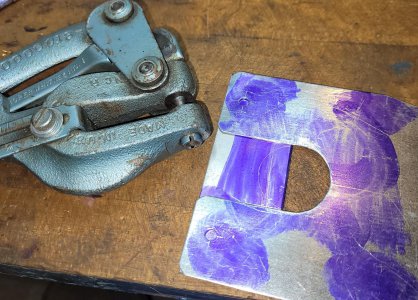
Set the aluminum plate in the Bridgeport and found the scribed holes with a laser center/edge finder. This model projects concentric circles. You move the quill up/down to change the diameters for alignment to a scribed line.
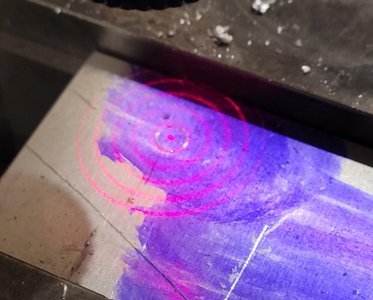
Center drill
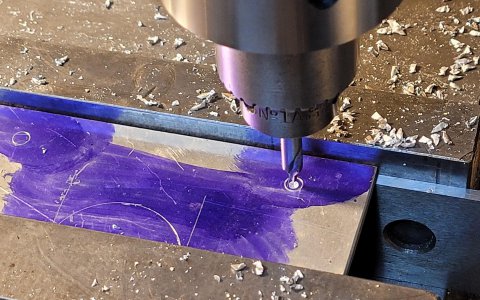
Tap drill
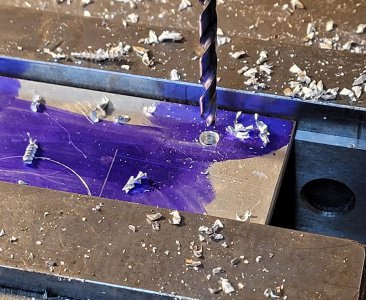
Power tapping a 10-24
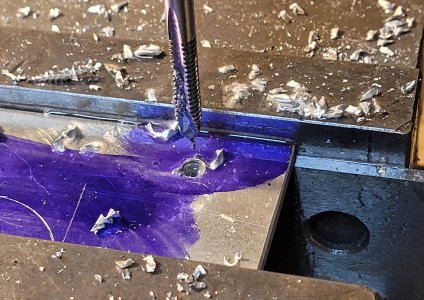
Used a 3/4" ball-end mill to rough in the radii for the inlet hose. Didn't show it, but cleaned up the edge with a drum sander on the drill press.
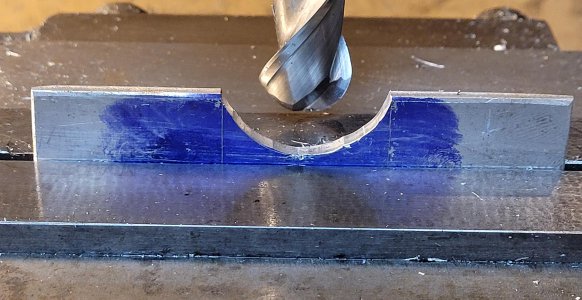
Bent up the bracket with the DiAcro brake
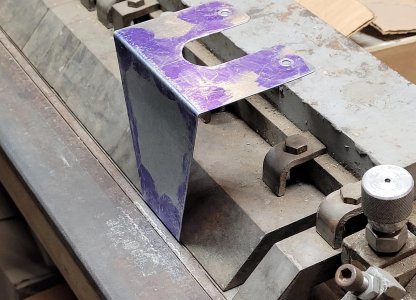
The bracket bottom leg sets between the two bottom outlets and captures the bottom face of the manifold. The top open-ended slot slips around the inlet hose fitting and is secured with the aluminum plate.
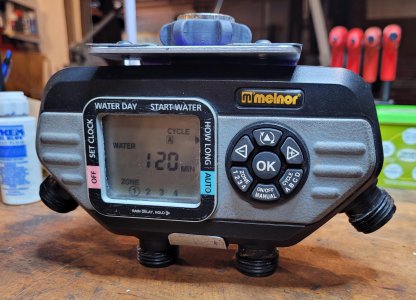
Still need to spray some Rustoleum and screw the bracket to a piece of 3/4" foundation grade plywood on the side of my wife's garden bed.
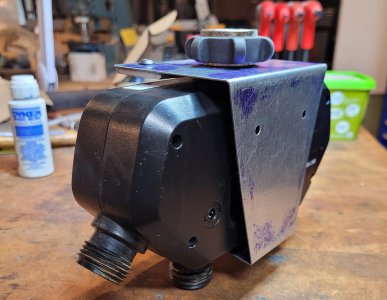
Though it is galvanized, I’ll paint it with Rustoleum primer. Plan is to screw it to a piece of ¾” foundation grade plywood which is screwed to the side of one of the beds. Wife is happy, life is good!
Thanks for looking,
Bruce
I plumbed a hydrant to her garden for watering which she runs into a 4-zone programmable manifold. One water line runs in, up to 4 lines run out to different parts of her garden. Each zone has sprinkler lines running through the beds. She can program in the number of hours each zone gets water. On top of it all, the manifold has provisions for a moisture sensor so it only kicks on if the ground is dry.
She used to mount the manifold directly on a “Y” off the hydrant. Problem is our well water has a fine silt in it even after 29 years in our house. The house has a large whole-house filter to keep from plugging up the water softener, but the “T” to the garden/shop is unfiltered. Her small trickle hose end fittings were getting clogged and needed to be flushed every year. Our solution was to add a whole-house filter like in the house, but that meant the manifold would need to be remote mounted. Hence, the project of the day.
Now that I have a working sheet metal shear (see the above POTD. . .), my material of choice was 16-gauge galvanized. I cut a piece of chipboard for a prototype. Dykem’d up the 16-gauge and started punching/cutting. The bracket is “U” shaped with a tab on the bottom that captures the bottom edge of the manifold. The top is secured with a piece of 1/8” aluminum which screws to the bracket.
I needed a 1 1/4" hole but my punches for the Roper Whitney 218 press go from 7/8" up to 1 1/2". So, nibbled away at the 1 1/4" hole with the 7/8" punch

Used a 1/2" x 3/4" rectangular punch to knock in the open-ended slot that will capture the inlet hose fitting

Trimmed the sides of the blank with a 6" corner notcher

Radiused the corners (sander would work too)

Set the 1/8" aluminum retaining plate in place, scribed the remainder of the 1 1/4" hole for capturing the inlet hose, and traced the outline of the mounting screw holes onto the aluminum.

Set the aluminum plate in the Bridgeport and found the scribed holes with a laser center/edge finder. This model projects concentric circles. You move the quill up/down to change the diameters for alignment to a scribed line.

Center drill

Tap drill

Power tapping a 10-24

Used a 3/4" ball-end mill to rough in the radii for the inlet hose. Didn't show it, but cleaned up the edge with a drum sander on the drill press.

Bent up the bracket with the DiAcro brake

The bracket bottom leg sets between the two bottom outlets and captures the bottom face of the manifold. The top open-ended slot slips around the inlet hose fitting and is secured with the aluminum plate.

Still need to spray some Rustoleum and screw the bracket to a piece of 3/4" foundation grade plywood on the side of my wife's garden bed.

Though it is galvanized, I’ll paint it with Rustoleum primer. Plan is to screw it to a piece of ¾” foundation grade plywood which is screwed to the side of one of the beds. Wife is happy, life is good!
Thanks for looking,
Bruce
- Joined
- Aug 6, 2015
- Messages
- 3,862
Some progress with the build of the drill press float lock vise... even if baby steps...
I am probably not doing this in the correct order... but what the heck...
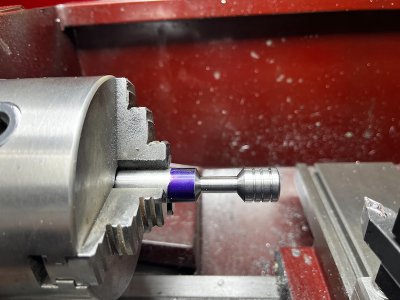
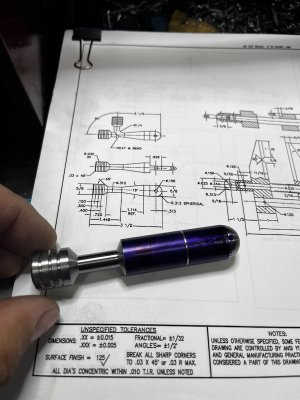
Now I need to figure out how to make that tapered section... guess I need to install this back on the lathe...
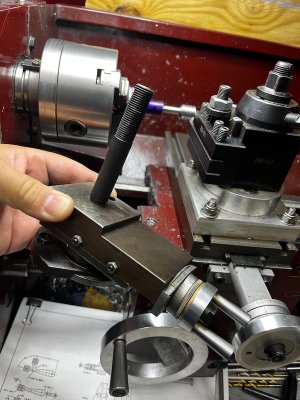
So a few things that I am learning:
1. I really want a DRO in my lathe... spacing on the grooves sucks... not even. Does not matter for this project as those are just decorative, but it burns me to see them with different spacing/width. I measured them several times... marked them to have a reference and not rely only on the dial... still... good grief...
2. I can now understand why I need a better caliper... I hate it when this one turns off and I turn it on only to have to reset zero... after awhile it gets to me...
3. I need more tools... but this never ends, it seems...
I am probably not doing this in the correct order... but what the heck...


Now I need to figure out how to make that tapered section... guess I need to install this back on the lathe...

So a few things that I am learning:
1. I really want a DRO in my lathe... spacing on the grooves sucks... not even. Does not matter for this project as those are just decorative, but it burns me to see them with different spacing/width. I measured them several times... marked them to have a reference and not rely only on the dial... still... good grief...
2. I can now understand why I need a better caliper... I hate it when this one turns off and I turn it on only to have to reset zero... after awhile it gets to me...
3. I need more tools... but this never ends, it seems...
Last edited:
- Joined
- Dec 18, 2019
- Messages
- 6,428
@wachuko As an interim measure, install a dial indicator on your ways to measure carriage movement. I bought a cheap 2" travel dial indicator for my mini-lathe. Makes the lack of carriage DRO more tolerable. My bigger lathe as a DRO, and have to agree, it's more convenient than using the dial indicator, but the DRO is not any more accurate.
- Joined
- Aug 6, 2015
- Messages
- 3,862
I have one and forgot to use it@wachuko As an interim measure, install a dial indicator on your ways to measure carriage movement. I bought a cheap 2" travel dial indicator for my mini-lathe. Makes the lack of carriage DRO more tolerable. My bigger lathe as a DRO, and have to agree, it's more convenient than using the dial indicator, but the DRO is not any more accurate.
 . I just can't fix stupid....
. I just can't fix stupid.... - Joined
- Dec 18, 2019
- Messages
- 6,428
Hope you remember it next time!I have one and forgot to use it
- Joined
- Nov 23, 2014
- Messages
- 2,606
You'll love a DRO on the lathe for accurate positioning along the Z-axis. Cutting to a shoulder depth, groove position, etc. is so much nicer. I have a 2" indicator on my Clausing with a magnetic base. It works, but punching in the number is more convenient.So a few things that I am learning:
1. I really want a DRO in my lathe... spacing on the grooves sucks... not even. Does not matter for this project as those are just decorative, but it burns me to see them with different spacing/width. I measured them several times... marked them to have a reference and not rely only on the dial... still... good grief...
One thing I haven't done on mine yet is a suggestion from I believe @macardoso. Most of the DRO's have something like 200 datums on them. He plugged in offsets for his lathe tools for the diameter/radius. Nice feature as you should be able to swap tools, plug the new tool number in the DRO and your radius/diameter cross feed position automatically adjusts for the new tool.
Bruce


